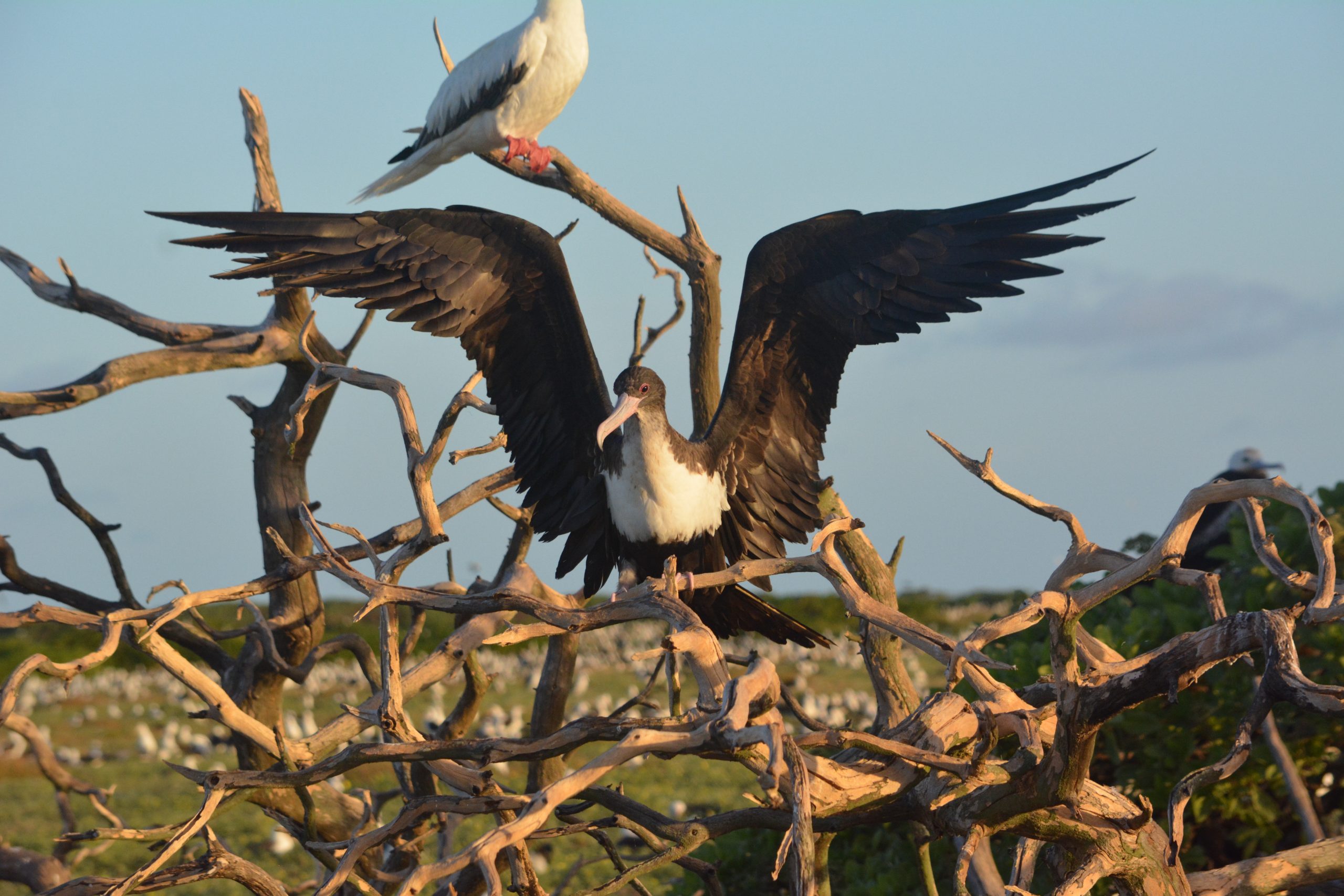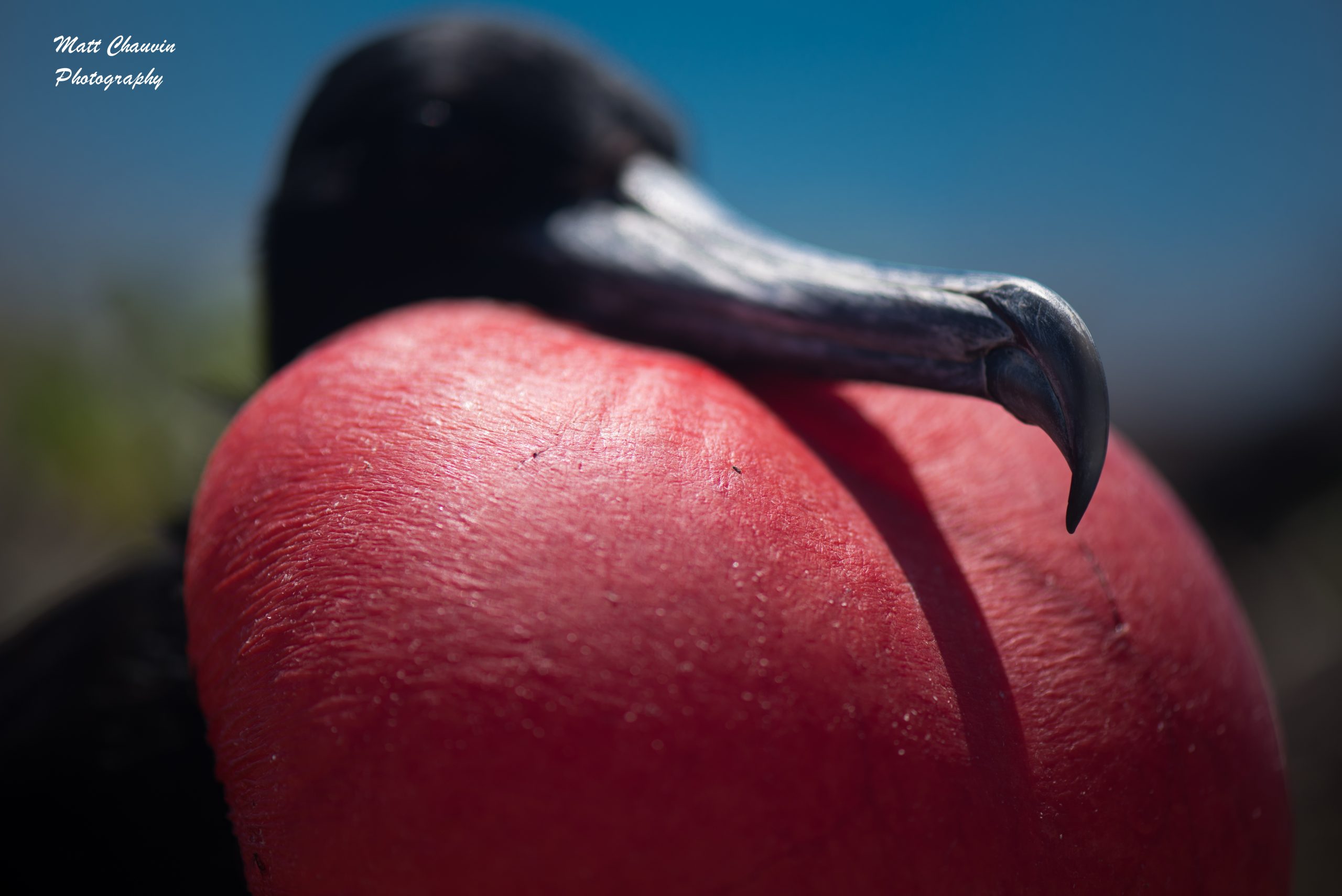ʻIwa

Names
- ʻŌlelo Hawaiʻi: ʻIwa
- Common: Great Frigatebird
- Scientific: Fregata minor
Song
Conservation Status
- IUCN Red List Ranking – Least Concern
Species Information
The ‘iwa or great frigatebird is a large, graceful seabird (Family: Fregatidae) related to boobies and tropicbirds, with a distribution in tropical regions in both hemispheres. Five ‘iwa (great frigatebird) subspecies are recognized, and one (F. m. palmerstoni) breeds in Hawai‘i. Individuals have slim bodies, a long deeply forked tail, a long hooked bill, and almost useless legs and feet. Adult males are almost entirely black, with varying amounts of a dark green sheen on head and neck; during courtship males inflate large, red gular pouch. Adult females are larger than males, and are black with a white breast patch and a gray throat; both sexes may have a buff bar on the upper surface of wings. Flight is characterized by long periods of soaring. An adept aerial flier, the species obtains some of its food by harassing other seabirds until they regurgitate their prey. Although ‘iwa (great frigatebird) captures most of its own prey, this behavior inspired both its Hawaiian and English names: ‘iwa means “thief” and “frigate” refers to the fast ships used by pirates. Often feeds far from land alone or in pairs, but will join mixed species feeding flocks, especially ‘ewa‘ewa or sooty terns (Sterna fuscatata) and ‘ua‘u kani or wedge-tailed shearwaters (Puffinus pacificus), feeding over schools of predatory fishes. ‘Iwa (great frigatebird) take prey on the wing, seizing it by dipping bill into water or from the air. In Hawai‘i, diet primarily consists of flyingfish and squid. Nests in colonies, often with other species, ranging from ten to thousands of pairs, and constructs platform nests in low bushes. Unlike many seabirds, pairs usually switch partners every breeding season, likely because females often only nest every two to four years. Both parents incubate single egg, and brood and feed chick. Post-fledging (after first flight) feeding is provided by female for up to 18 months. Birds first breed at eight to ten years of age, and the oldest known individual was 37 years old.
Distribution
‘Iwa (great frigatebird) breed throughout the NWHI. Large numbers roost on offshore islets of the MHI, but breeding has not been documented. Outside of Hawai‘i, ‘iwa (great frigatebird) nest on islands mainly in the tropical Atlantic, Indian, and Pacific oceans. Outside the breeding season, adults remain relatively close to breeding colonies, but young and nonbreeders disperse throughout tropical oceans.
Habitat
Terrestrial: ‘Iwa (great frigatebird) breed and roost on small remote islands, typically within regions with tradewinds. Builds nests in the tops of various species of bushes and trees, including beach naupaka (Scaevola sericea), beach heliotrope (Tournefortia argentea), pisonia trees (Pisonia grandis), and mangrove trees (Brugiera spp., Rhizophora spp.) Marine: Pelagic.
Threats
- Introduced predators. Like all seabirds, adults and nests susceptible to predation by rats (Rattus spp.) and feral cats (Felis silvestris). All sites in NWHI are free of rats and cats.
- Habitat degradation. Introduced herbivores, insects, and plants can degrade native vegetation used for nesting. Rabbits (Oryctolagus cuniculus) denuded vegetation on Laysan, Lisianski, and Lehua islands greatly reducing nesting habitat; with the eradication of rabbits, Laysan and Lisianski have since recovered and support large colonies.
- Overfishing. Because ‘iwa (great frigatebird) rely on predatory fish to drive prey to the surface, overfishing may eventually affect Hawaiian populations.
Plans & Projects
- Kauaʻi Endangered Seabird Recovery Project (KESRP)
- Maui Nui Seabird Recovery Project (MNSRP)
- Lehua Island Ecosystem Restoration Project
- Kaʻena Point Ecosystem Restoration Project
Photos
Additional Resources
For more information and references visit the DLNR State Wildlife Action Plan factsheets. DOFAWʻs species pages and State Wildlife Action Plan fact sheets are provided for general information and are not meant to be a citable, original source of data. If you are a student, researcher, or writer looking for a citable source, please explore the references below or find other original data sources, rather than citing these webpages. The references below were provided by the authors of the State Wildlife Action Plan fact sheets at the time of drafting:
- Metz VG, Schreiber EA. 2002. Great frigatebird (Fregata minor) In The Birds of North America, No. 681 (Poole A, Gill F, editors.). Philadelphia, (PA): The Academy of Natural Sciences; and Washington DC: The American Ornithologists’ Union.
- Kushlan JA, et al. 2002. Waterbird Conservation for the Americas: The North American waterbird conservation plan, Version 1 Waterbird Conservation for the Americas, Washington, DC. 78pp. Available at: www.waterbirdconservation.org.
- NatureServe. 2003. Downloadable animal data sets. NatureServe Central Databases. Available at: https://www.natureserve.org/getData/vertinvertdata.jsp (March 10, 2005).
- U.S. Fish and Wildlife Service. 2005. Regional seabird conservation plan, Pacific Region. U.S. Fish and Wildlife Service, Migratory Birds and Habitat Programs, Pacific Region. Portland, (OR): U.S. Fish and Wildlife Service.


